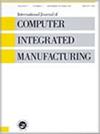Smart manufacturing under limited and heterogeneous data: a sim-to-real transfer learning with convolutional variational autoencoder in thermoforming
IF 4
3区 工程技术
Q2 COMPUTER SCIENCE, INTERDISCIPLINARY APPLICATIONS
International Journal of Computer Integrated Manufacturing
Pub Date : 2023-09-22
DOI:10.1080/0951192x.2023.2257623
引用次数: 0
Abstract
ABSTRACTData in advanced manufacturing are often sparse and collected from various sensory devices in a heterogeneous and multi-modal fashion. Thus, for such intricate input spaces, learning robust and reliable predictive models for product quality assessments entails implementing complex nonlinear models such as deep learning. However, these ‘data-greedy’ models require massive datasets for training, and they tend to exhibit poor generalization performance otherwise. To address the data paucity and the data heterogeneity in smart manufacturing applications, this paper introduces a sim-to-real transfer-learning framework. Specifically, using a unified wide-and-deep learning approach, the model pre-processes structured sensory data (wide) as well as high-dimensional thermal images (deep) separately, and then passes the respective concatenated features to a regressor for predicting product quality metrics. Convolutional variational autoencoder (ConvVAE) is utilized to learn concise representations of thermal images in an unsupervised fashion. ConvVAE is trained via a sim-to-real transfer learning approach, backed by theory-based heat transfer simulations. The proposed metamodeling framework was evaluated in an industrial thermoforming process case study. The results suggested that ConvVAE outperforms conventional dimensionality reduction methods despite limited data. A model explainability analysis was conducted and the resulting SHAP values demonstrated the agreement between the model’s predictions, theoretical expectations, and data correlation statistics.KEYWORDS: Intelligent manufacturingtransfer learningconvolutional variational autoencoderthermoformingmodel explainability AcknowledgementsThe authors would like to thank colleagues’ support and helpful comments at the Composites Research Network (CRN) and the University of British Columbia, especially, Mr Kurt Yesilcimen for his assistance during the data collection phase. The authors would also like to sincerely recognize the contribution of their industrial collaborator, Hytec Kohler Canada and in particular Mr Diego Faiguenbaum.Disclosure statementNo potential conflict of interest was reported by the author(s).Supplemental dataSupplemental data for this article can be accessed online at https://doi.org/10.1080/0951192X.2023.2257623Additional informationFundingThis study was financially supported by the New Frontiers in Research Fund (NFRF) of Canada – Exploration stream (award number: NFRFE-2019-01440).有限和异构数据下的智能制造:基于卷积变分自编码器的模拟到真实的热成形迁移学习
摘要先进制造中的数据通常是稀疏的,并且以异构和多模态的方式从各种感官设备中收集。因此,对于如此复杂的输入空间,学习稳健可靠的产品质量评估预测模型需要实现复杂的非线性模型,如深度学习。然而,这些“数据贪婪”模型需要大量的数据集进行训练,否则它们往往表现出较差的泛化性能。为了解决智能制造应用中数据缺乏和数据异构的问题,本文引入了一个模拟到真实的迁移学习框架。具体来说,该模型使用统一的宽学习和深度学习方法,分别对结构化感官数据(宽)和高维热图像(深)进行预处理,然后将各自的连接特征传递给回归器,用于预测产品质量指标。利用卷积变分自编码器(ConvVAE)以无监督的方式学习热图像的简洁表示。ConvVAE通过模拟到真实的迁移学习方法进行训练,并以基于理论的传热模拟为基础。在工业热成形过程案例研究中对所提出的元建模框架进行了评估。结果表明,尽管数据有限,ConvVAE仍优于传统的降维方法。进行了模型可解释性分析,得出的SHAP值证明了模型预测、理论期望和数据相关统计之间的一致性。关键词:智能制造迁移学习卷积变分自编码器热成型模型可解释性致谢作者要感谢复合材料研究网络(CRN)和不列颠哥伦比亚大学的同事们的支持和有益的评论,特别是Kurt Yesilcimen先生在数据收集阶段的帮助。作者也衷心感谢他们的工业合作伙伴Hytec Kohler Canada,特别是Diego Faiguenbaum先生的贡献。披露声明作者未报告潜在的利益冲突。本研究由加拿大新前沿研究基金(NFRF)资助-探索流(奖励号:NFRFE-2019-01440)。
本文章由计算机程序翻译,如有差异,请以英文原文为准。
求助全文
约1分钟内获得全文
求助全文
来源期刊
CiteScore
9.00
自引率
9.80%
发文量
73
审稿时长
10 months
期刊介绍:
International Journal of Computer Integrated Manufacturing (IJCIM) reports new research in theory and applications of computer integrated manufacturing. The scope spans mechanical and manufacturing engineering, software and computer engineering as well as automation and control engineering with a particular focus on today’s data driven manufacturing. Terms such as industry 4.0, intelligent manufacturing, digital manufacturing and cyber-physical manufacturing systems are now used to identify the area of knowledge that IJCIM has supported and shaped in its history of more than 30 years.
IJCIM continues to grow and has become a key forum for academics and industrial researchers to exchange information and ideas. In response to this interest, IJCIM is now published monthly, enabling the editors to target topical special issues; topics as diverse as digital twins, transdisciplinary engineering, cloud manufacturing, deep learning for manufacturing, service-oriented architectures, dematerialized manufacturing systems, wireless manufacturing and digital enterprise technologies to name a few.

 求助内容:
求助内容: 应助结果提醒方式:
应助结果提醒方式:


